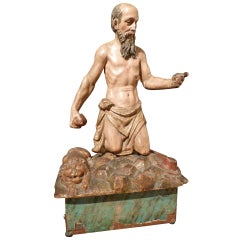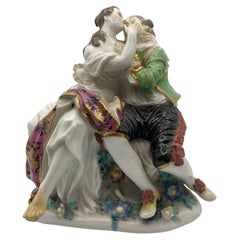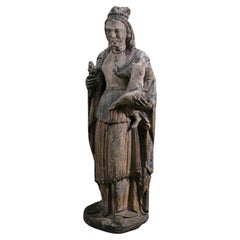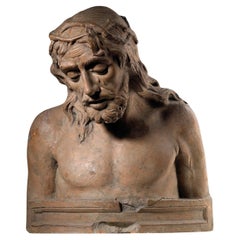Figurative Sculptures
17th Century Spanish Baroque Antique Figurative Sculptures
Wood
1740s German Rococo Antique Figurative Sculptures
Porcelain
15th Century and Earlier Mexican Pre-Columbian Antique Figurative Sculptures
Stone
16th Century French Renaissance Antique Figurative Sculptures
Limestone
15th Century and Earlier Italian Renaissance Antique Figurative Sculptures
Terracotta
15th Century and Earlier South American Pre-Columbian Antique Figurative Sculptures
Ceramic
Mid-18th Century Italian Neoclassical Antique Figurative Sculptures
Marble
18th Century Ecuadorean Antique Figurative Sculptures
Glass, Wood
1890s French Rococo Antique Figurative Sculptures
Terracotta
16th Century Chinese Ming Antique Figurative Sculptures
Bronze
17th Century German Industrial Antique Figurative Sculptures
Wood
15th Century and Earlier European Gothic Antique Figurative Sculptures
Oak
Mid-17th Century Italian Baroque Antique Figurative Sculptures
Pine
15th Century and Earlier Egyptian Egyptian Antique Figurative Sculptures
Stone
16th Century Chinese Antique Figurative Sculptures
Porcelain
17th Century Spanish Baroque Antique Figurative Sculptures
Other
Mid-18th Century Italian Baroque Antique Figurative Sculptures
Gesso, Wood, Paint
1890s Art Nouveau Antique Figurative Sculptures
Bronze
1890s French Art Nouveau Antique Figurative Sculptures
Marble
1890s French Napoleon III Antique Figurative Sculptures
Marble
16th Century Chinese Ming Antique Figurative Sculptures
Organic Material
18th Century English George III Antique Figurative Sculptures
Porcelain
Early 1700s Italian Antique Figurative Sculptures
Wood
Late 18th Century Antique Figurative Sculptures
Porcelain
1890s French Art Nouveau Antique Figurative Sculptures
Bronze
18th Century Antique Figurative Sculptures
Glass, Paint
1890s French Art Nouveau Antique Figurative Sculptures
Bronze
Mid-17th Century Chinese Antique Figurative Sculptures
Porcelain
17th Century Italian Renaissance Antique Figurative Sculptures
Carrara Marble
1750s Italian Antique Figurative Sculptures
Wood
Early 18th Century French Antique Figurative Sculptures
Wood
17th Century Italian Antique Figurative Sculptures
Terracotta
Early 1600s Italian Antique Figurative Sculptures
Wood
18th Century English George III Antique Figurative Sculptures
Porcelain
1890s French Art Nouveau Antique Figurative Sculptures
Bronze
18th Century English George III Antique Figurative Sculptures
Porcelain
15th Century and Earlier Chinese Antique Figurative Sculptures
Earthenware
15th Century and Earlier Mexican Pre-Columbian Antique Figurative Sculptures
Stone
17th Century Antique Figurative Sculptures
Wood
16th Century Renaissance Antique Figurative Sculptures
Bronze
1780s Italian Napoleon III Antique Figurative Sculptures
Pine
Mid-17th Century European Baroque Antique Figurative Sculptures
Pine
Mid-18th Century European Baroque Antique Figurative Sculptures
Wood
1890s Italian Renaissance Revival Antique Figurative Sculptures
Iron
15th Century and Earlier Italian Classical Roman Antique Figurative Sculptures
Marble
18th Century Spanish Other Antique Figurative Sculptures
Wood
15th Century and Earlier Chinese Antique Figurative Sculptures
Earthenware
1750s Dutch Baroque Antique Figurative Sculptures
Wood
16th Century Antique Figurative Sculptures
Wood
1890s European Late Victorian Antique Figurative Sculptures
Earthenware
18th Century Guatemalan Spanish Colonial Antique Figurative Sculptures
Leather, Wood
15th Century and Earlier Antique Figurative Sculptures
Wood
16th Century Antique Figurative Sculptures
Wood
16th Century Antique Figurative Sculptures
Oak
15th Century and Earlier Antique Figurative Sculptures
Wood
17th Century German Gothic Antique Figurative Sculptures
Oak
15th Century and Earlier Antique Figurative Sculptures
Wood
16th Century Antique Figurative Sculptures
Wood
Antique, New and Vintage Figurative Sculptures
Figurative sculpture is a modern art form in which artists create work that is typically representative of the visible world. However, sculptures that are considered to be figurative in style can definitely be inclusive of abstract elements. A wide range of antique, new and vintage figurative sculptures has been made over the years by both well-known and emerging artists, and these pieces can prove striking and provocative as part of your home decor.
Realistic representation in visual art has a very long history. And while figurative artists, whether figurative painters or sculptors, find inspiration in humans, animals and real-life objects, good figurative sculptures can make us think differently about how the real world should look. Just as figurative paintings might include Photorealistic human likenesses, they can also include elements of Surrealism and can suggest a creative and alternative reality. Figurative sculptures aren’t always realistic impressions of our world — depictions of the human form in classical Greek sculpture, for example, might emphasize beauty and physical perfection.
There are a variety of figurative sculptures on 1stDibs created by artists working in a number of styles, including Art Deco, Art Nouveau, mid-century modern and more. A large figurative sculpture can introduce an excellent focal point in a guest bedroom, while smaller works might draw the eye to spaces such as wall shelving or a bookcase that people may otherwise overlook.
When decorating your living room, dining room, home office and study areas with figurative sculptures, don’t be afraid to choose bold colors to inject brightness into neutral spaces. Texture is another factor to consider when purchasing figurative sculptures. A highly textural work of ceramics or wood will catch the eye in a sleek modern space, whereas a smooth, flat glass sculpture can offer an often much-needed contrast in a room that already has many textures.
On 1stDibs, find antique, new or vintage figurative sculpture or other kinds of sculpture for your home decor today.




